Finding the perfect hair color when you have pale skin and green eyes can feel like searching for a needle in a haystack, but the right shade can transform your entire appearance and make those emerald irises absolutely mesmerizing.
The unique combination of fair complexion and green eyes offers a stunning canvas that pairs beautifully with specific color families, from warm coppers that ignite your natural radiance to cool ash tones that create sophisticated contrast.
This comprehensive guide explores 26 flattering hair colors for pale skin with green eyes that turn heads, providing detailed insights into warm tones, cool shades, and dramatic options that complement your coloring while enhancing your best features.
Whether you’re considering a subtle change or a bold transformation, understanding which hues work harmoniously with your skin’s undertones and eye color will help you make confident choices that leave you feeling radiant.
Each color recommendation includes styling tips, maintenance advice, and expert insights to ensure your new look not only flatters but also remains vibrant and healthy.
Contents
- 1 1. Strawberry Blonde: The Perfect Warm-Toned Classic
- 2 2. Rich Auburn: Deep Warmth with Dramatic Impact
- 3 3. Copper Penny: Vibrant Red-Orange Brilliance
- 4 4. Ash Blonde: Cool-Toned Sophistication
- 5 5. Mahogany Brown: Rich Chocolate with Red Undertones
- 6 6. Rose Gold: Trendy Pink-Copper Fusion
- 7 7. Honey Blonde: Warm Golden Radiance
- 8 8. Burgundy: Deep Wine-Red Elegance
- 9 9. Caramel Highlights: Subtle Sun-Kissed Dimension
- 10 10. Platinum Blonde: Bold Cool-Toned Drama
- 11 11. Chestnut Brown: Classic Warmth and Depth
- 12 12. Ginger Red: Vibrant Natural Red Tones
- 13 13. Champagne Blonde: Soft Neutral Elegance
- 14 14. Espresso Brown: Rich Cool-Toned Depth
- 15 15. Peach Tones: Soft Pastel Warmth
- 16 16. Dark Auburn: Sophisticated Red-Brown Balance
- 17 17. Sandy Blonde: Natural Beach-Inspired Tones
- 18 18. Copper Brown: Warm Dimensional Richness
- 19 19. Icy Blonde: Cool Platinum Variant
- 20 20. Warm Brunette: Rich Brown with Golden Undertones
- 21 21. Red-Violet: Bold Purple-Red Fusion
- 22 22. Golden Brown: Warm Medium-Depth Balance
- 23 23. Mahogany Red: Deep Red with Brown Richness
- 24 24. Butterscotch Blonde: Rich Golden-Blonde Warmth
- 25 25. Cool Brown: Ash-Toned Sophistication
- 26 26. Bright Red: Bold Primary Color Statement
- 27 Understanding Your Skin’s Undertones
- 28 Color Selection Guide by Season
- 29 Professional Consultation Tips
- 30 Hair Health and Color Maintenance
- 31 Makeup Coordination for Enhanced Results
- 32 Budget Considerations and Salon Selection
- 33 Lifestyle Compatibility Assessment
- 34 Transitioning Between Colors
- 35 Common Mistakes to Avoid
- 36 Seasonal Color Refresh Ideas
- 37 The Psychology of Hair Color Change
- 38 Conclusion
1. Strawberry Blonde: The Perfect Warm-Toned Classic
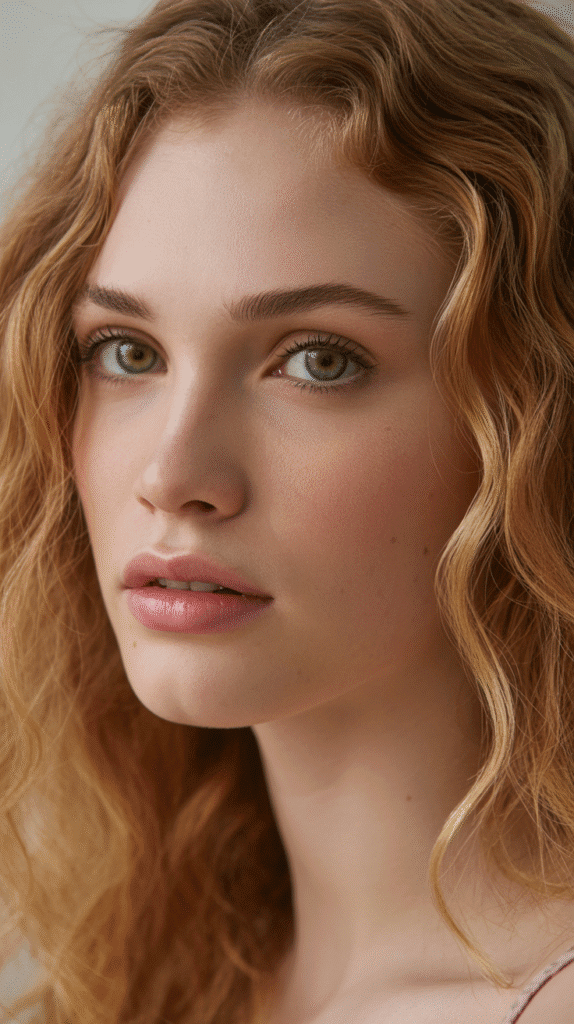
Strawberry blonde creates a delicate balance between red and blonde that beautifully complements pale skin while making green eyes pop with intensity.
This soft, romantic shade contains warm peachy-pink undertones that add warmth to fair complexions without overwhelming delicate features.
Why It Works:
- The golden and rose tones in strawberry blonde create natural warmth that prevents pale skin from appearing washed out.
- This shade contains enough red pigment to create stunning contrast with green eyes, making them appear more vibrant and noticeable.
- Strawberry blonde reflects light beautifully, giving fair skin a healthy, luminous glow that looks fresh and youthful.
- The multidimensional nature of this color adds depth and movement, creating visual interest that flatters pale complexions.
Maintenance Tips:
- Use purple-toned shampoos weekly to prevent the blonde tones from turning brassy or yellow.
- Apply color-depositing conditioners specifically formulated for strawberry blonde to maintain the pink-gold balance.
- Protect your hair from sun exposure with UV-protectant sprays, as this delicate color fades quickly in sunlight.
- Schedule touch-ups every 6-8 weeks to keep the roots seamless and the color vibrant.
2. Rich Auburn: Deep Warmth with Dramatic Impact
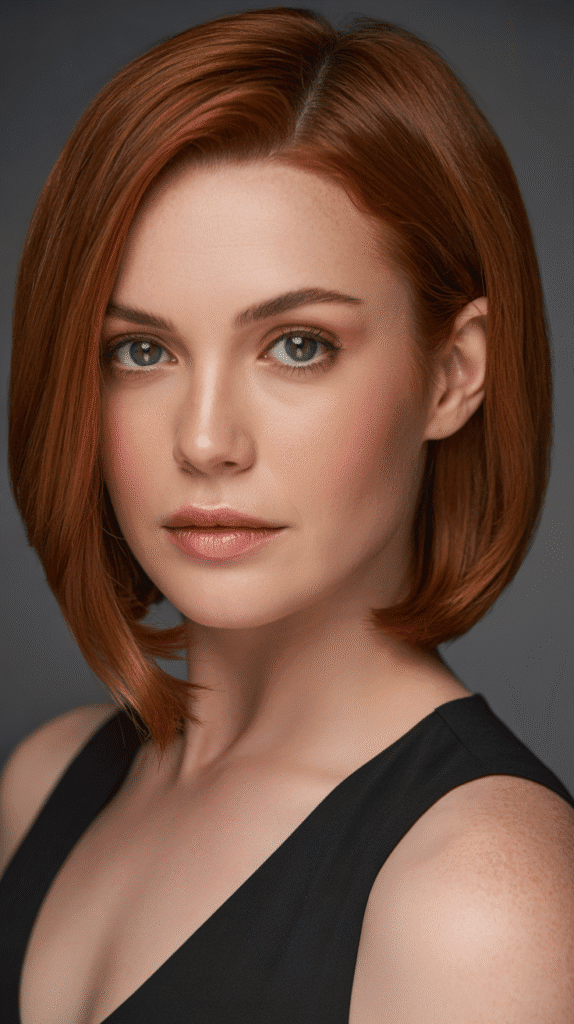
Auburn hair brings sophisticated depth with its blend of brown and rich red tones, creating a luxurious color that contrasts beautifully with pale skin while intensifying green eye color.
This classic shade has timeless appeal and works exceptionally well for those seeking a bold yet refined transformation.
Key Benefits:
- Auburn’s deep red-brown tones create striking contrast against fair skin, making your complexion appear more luminous and defined.
- The warm undertones complement the golden flecks often found in green eyes, creating a cohesive and harmonious overall appearance.
- This shade adds significant visual warmth to pale skin without requiring as much maintenance as lighter red tones.
- Auburn photographs exceptionally well, maintaining its richness and depth in various lighting conditions.
Styling Recommendations:
- Enhance auburn with copper-toned glosses between salon visits to maintain vibrancy and shine.
- Pair this color with peachy or bronze makeup tones that harmonize with the warm hair color.
- Consider adding subtle caramel highlights around the face to soften the overall look and add dimension.
- Use sulfate-free color-safe products to prevent premature fading and maintain the rich pigmentation.
3. Copper Penny: Vibrant Red-Orange Brilliance
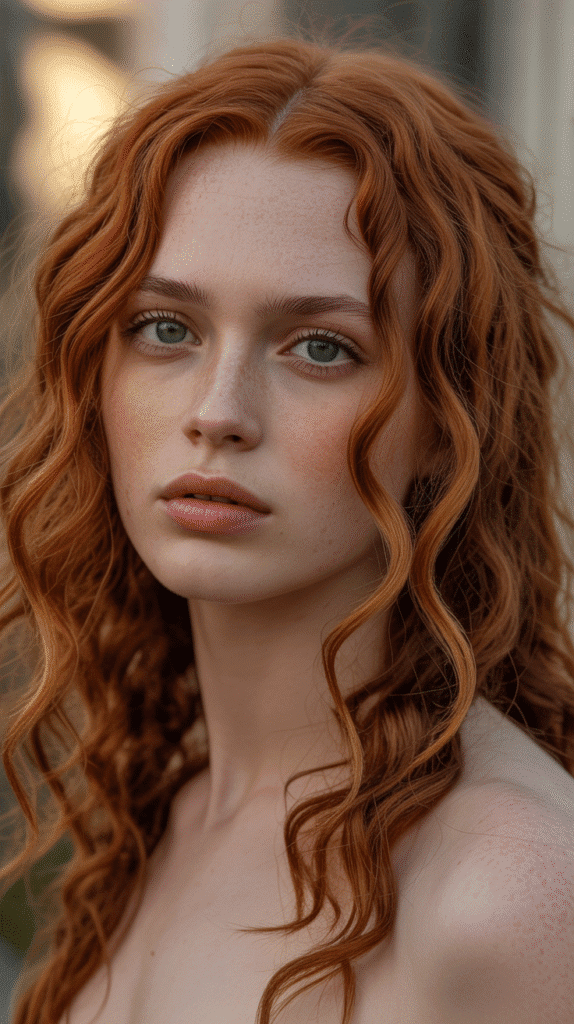
Copper penny represents one of the most eye-catching choices, featuring bright red-orange tones that create maximum impact against pale skin and make green eyes absolutely electric.
This bold shade requires confidence but delivers unparalleled drama and visual interest.
What Makes It Special:
- The intense warm tones in copper create the strongest possible contrast with fair skin, resulting in a truly head-turning appearance.
- Orange and red pigments are complementary to green on the color wheel, making this combination scientifically proven to enhance eye color.
- Copper reflects light brilliantly, giving hair incredible shine and dimension that catches attention from across a room.
- This shade works particularly well for those with warm or neutral undertones in their pale skin.
Care Requirements:
- Invest in high-quality color-depositing treatments specifically for copper tones to extend time between salon visits.
- Wash hair in cool water to seal the cuticle and prevent rapid color fade, as bright reds are notoriously high-maintenance.
- Apply deep conditioning masks weekly, as the lightening process required for copper can be damaging to hair structure.
- Avoid chlorinated pools entirely, as chlorine can turn copper tones greenish or brassy within a single swim.
4. Ash Blonde: Cool-Toned Sophistication
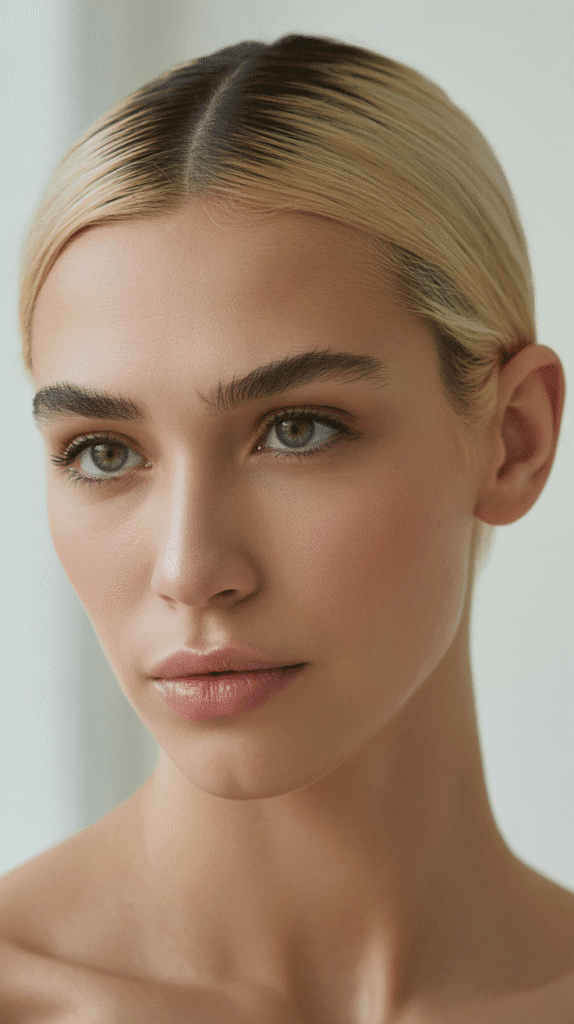
Ash blonde offers a completely different approach with its cool, silvery-blonde tones that create sophisticated contrast and give pale skin an almost porcelain quality.
This shade works particularly well for those with cool or pink undertones in their complexion.
Advantages:
- Cool ash tones prevent any yellow or orange cast that could clash with fair skin’s delicate coloring.
- The contrast between cool hair and warm green eyes creates an intriguing and unexpected combination that draws attention.
- Ash blonde gives a modern, fashion-forward appearance that looks polished and intentional.
- This shade can make pale skin appear more luminous by providing subtle contrast without harsh warmth.
Important Considerations:
- Ash blonde requires regular toning appointments every 3-4 weeks to prevent brassiness and maintain the cool undertones.
- This color works best for those with naturally lighter hair, as achieving ash blonde from dark hair requires significant lightening.
- Use purple shampoo 2-3 times weekly to neutralize warm tones and keep the ash color fresh.
- Consider balayage or highlights rather than solid ash blonde to add dimension and reduce maintenance.
5. Mahogany Brown: Rich Chocolate with Red Undertones
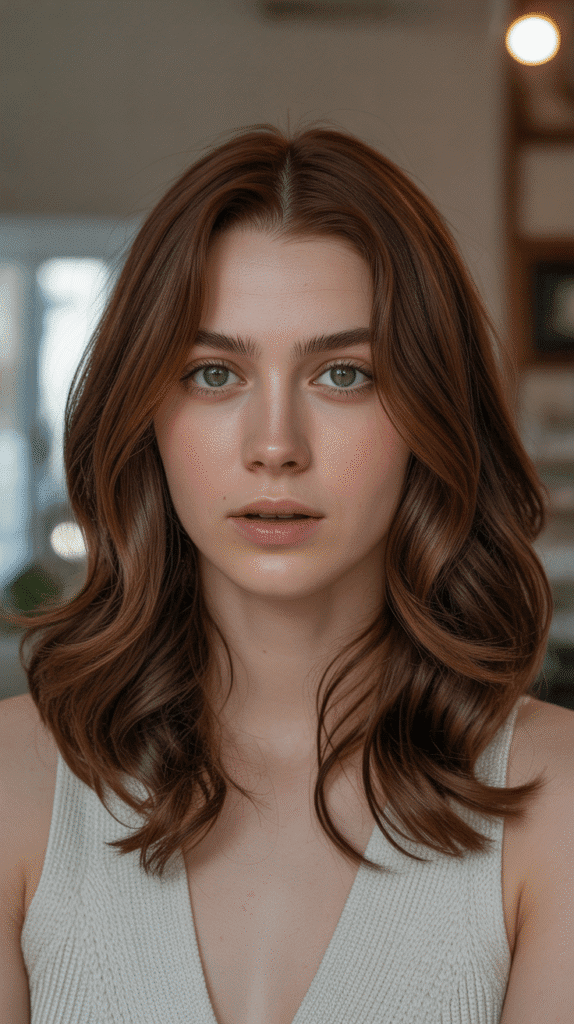
Mahogany brown combines the depth of chocolate brown with subtle red undertones, creating a sophisticated color that adds warmth to pale skin while providing enough contrast to make green eyes stand out.
This versatile shade works across multiple seasons and occasions.
Why Choose Mahogany:
- The red undertones prevent dark brown from looking too severe or harsh against very fair skin.
- Mahogany adds warmth and dimension without the high maintenance requirements of brighter red shades.
- This color creates a naturally polished appearance that works equally well in professional and casual settings.
- The depth of mahogany makes green eyes appear more luminous and jewel-toned by providing strong contrast.
Application Tips:
- Request mahogany with dimensional highlights to prevent the color from appearing flat or one-dimensional.
- Use gloss treatments every 4-6 weeks to maintain the red undertones and overall shine.
- Pair mahogany with warm-toned makeup like bronze eyeshadows and peachy blushes for cohesive looks.
- Protect from sun exposure with leave-in treatments containing UV filters to prevent fading to brassy tones.
6. Rose Gold: Trendy Pink-Copper Fusion
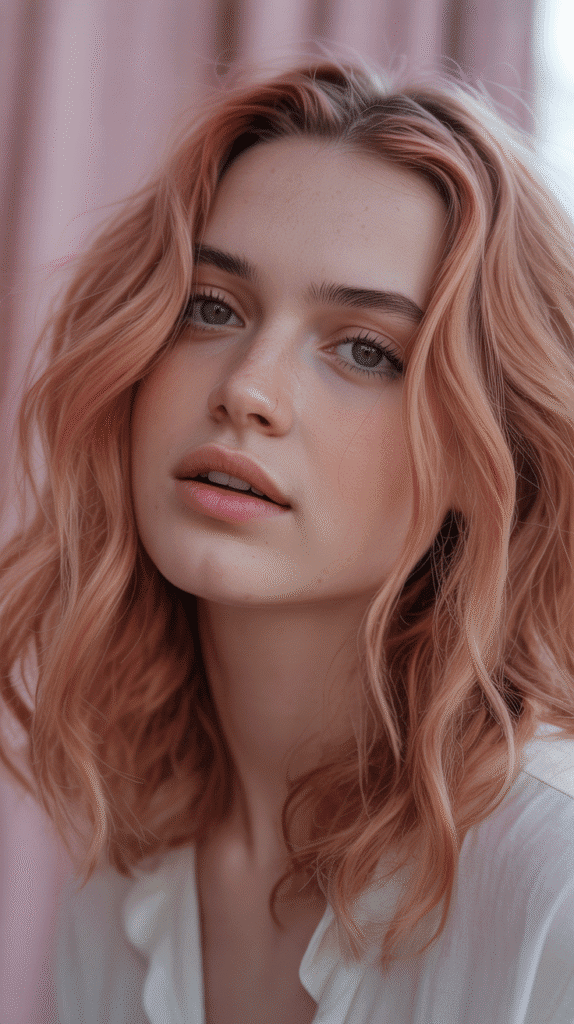
Rose gold has emerged as a contemporary favorite, blending pink and copper tones to create a unique shade that adds unexpected warmth to pale skin while complementing green eyes with its metallic dimension.
This modern color choice makes a statement without being overly dramatic.
Unique Qualities:
- The pink tones in rose gold add a soft, feminine quality that flatters fair complexions beautifully.
- Copper undertones create warmth and prevent the color from appearing too cool or artificial.
- Rose gold reflects light in interesting ways, creating multidimensional shine that changes in different lighting conditions.
- This shade works particularly well for those wanting to experiment with unconventional colors while maintaining wearability.
Maintenance Strategy:
- Alternate between pink and copper color-depositing conditioners to maintain the perfect rose gold balance.
- Schedule color refreshes every 4-6 weeks, as pastel-based colors fade more quickly than traditional shades.
- Use heat protectants religiously, as rose gold requires pre-lightening that leaves hair more vulnerable to damage.
- Consider starting with rose gold highlights or balayage before committing to an all-over application.
7. Honey Blonde: Warm Golden Radiance
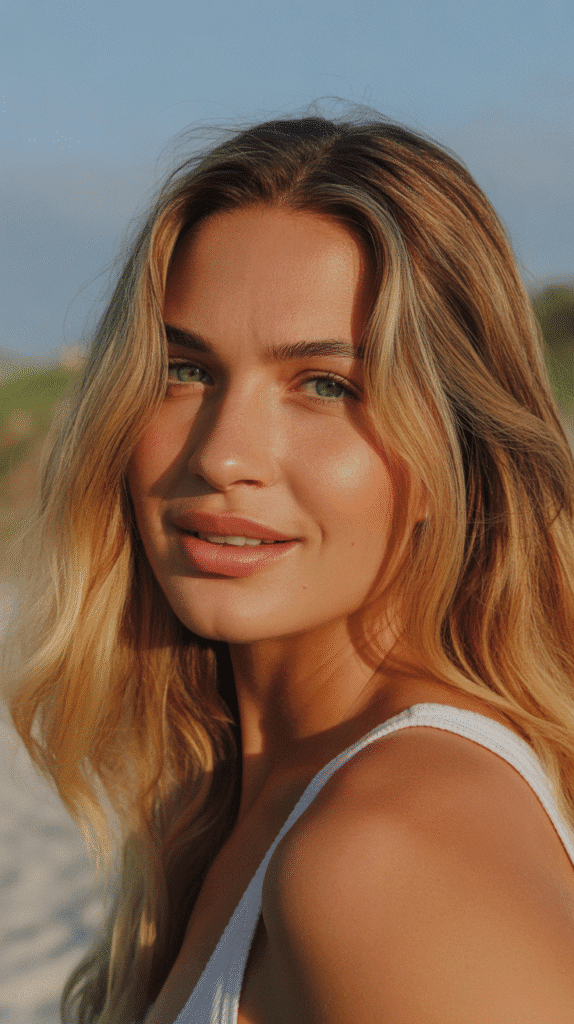
Honey blonde features rich golden tones that bring warmth and brightness to pale skin while creating a sun-kissed appearance that makes green eyes sparkle.
This approachable shade works beautifully for those seeking a natural-looking color transformation.
Benefits:
- Golden tones in honey blonde add warmth to fair skin, creating a healthy glow that looks naturally radiant.
- The multidimensional quality of honey blonde mimics natural sun-lightened hair, appearing effortless and organic.
- This shade complements the warm flecks in green eyes, creating harmony between hair and eye color.
- Honey blonde offers more versatility than platinum or ash tones, working with various makeup styles and fashion choices.
Achieving the Look:
- Request balayage or highlights rather than solid color for the most natural-looking honey blonde result.
- Incorporate both lighter and slightly deeper tones to create realistic dimension and depth.
- Use bond-building treatments during the lightening process to maintain hair health and integrity.
- Apply toning glosses that lean slightly warm rather than cool to maintain the honey quality.
8. Burgundy: Deep Wine-Red Elegance
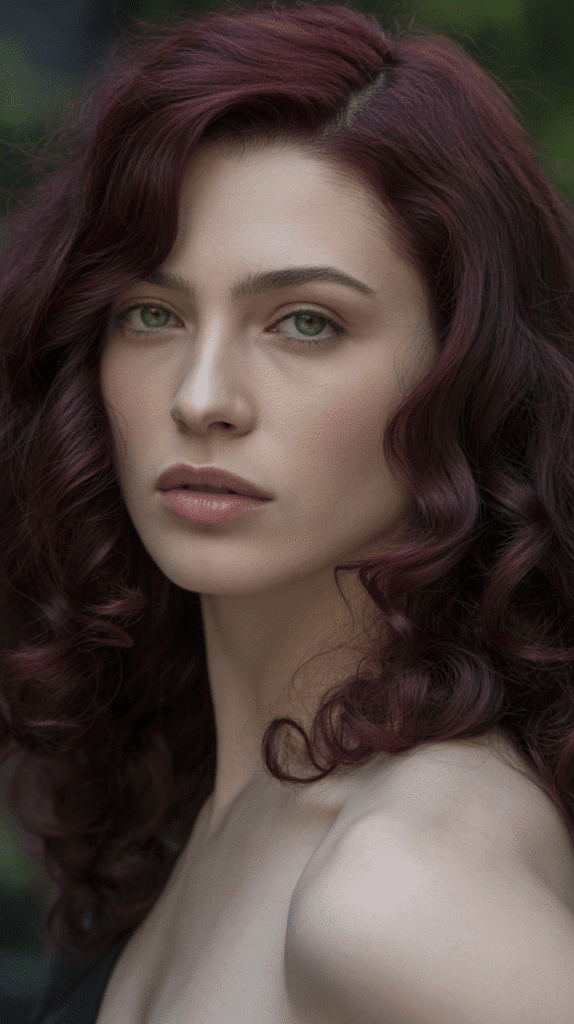
Burgundy offers deep, wine-red tones that create sophisticated drama against pale skin while making green eyes appear more intense and jewel-like.
This luxurious shade works particularly well during fall and winter months but maintains appeal year-round.
Distinctive Features:
- The deep purple-red tones in burgundy create rich contrast without the brightness of lighter reds.
- Burgundy adds warmth to fair skin while maintaining enough depth to look polished and refined.
- This shade photographs beautifully and maintains its integrity better than brighter red tones.
- The purple undertones complement green eyes by creating color wheel harmony and visual interest.
Care Instructions:
- Use color-depositing shampoos and conditioners specifically formulated for burgundy or red-violet tones.
- Limit washing to 2-3 times weekly, as frequent washing causes burgundy to fade toward orange.
- Apply glossing treatments every 3-4 weeks to refresh the color and maintain vibrancy between appointments.
- Avoid hot styling tools when possible, as heat accelerates fading in all red-based colors.
9. Caramel Highlights: Subtle Sun-Kissed Dimension
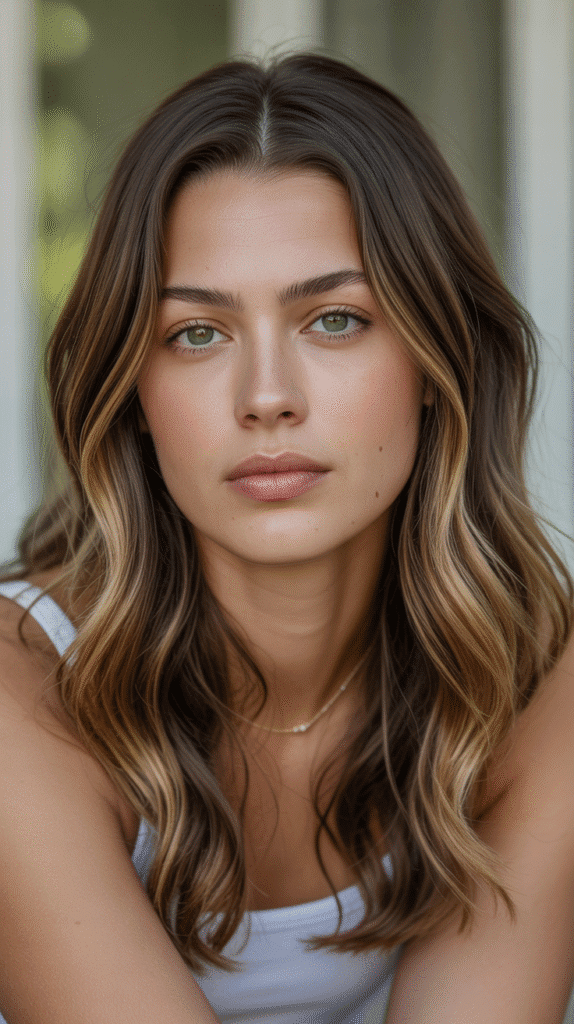
Caramel highlights offer a low-commitment way to add warmth and dimension to any base color, creating natural-looking depth that flatters pale skin and draws attention to green eyes.
This technique provides versatility and grows out gracefully.
Why They Work:
- Caramel tones add warmth around the face without requiring full color commitment or dramatic change.
- Highlights create dimension that prevents pale skin from appearing flat or one-dimensional.
- The multitonal effect mimics natural sun-lightening, making the color appear authentic and effortless.
- Caramel complements green eyes by adding golden warmth that harmonizes with natural eye pigmentation.
Placement Strategies:
- Focus caramel highlights around the face to frame features and brighten the complexion.
- Vary the thickness and spacing of highlights for a more natural, less striped appearance.
- Combine caramel with your natural base color or a slightly deeper brown for maximum dimension.
- Request face-framing pieces in slightly lighter tones to create a soft halo effect.
10. Platinum Blonde: Bold Cool-Toned Drama
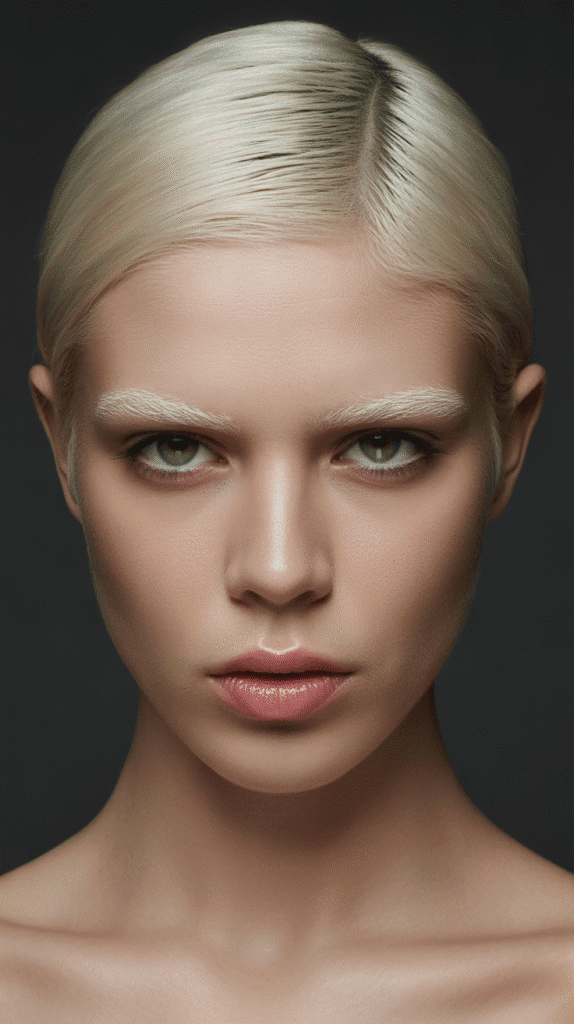
Platinum blonde represents the ultimate in cool-toned drama, creating striking contrast with pale skin and making green eyes appear extraordinarily vibrant.
This high-maintenance shade requires commitment but delivers unmatched visual impact.
Dramatic Impact:
- The extreme contrast between platinum hair and fair skin creates an ethereal, almost otherworldly appearance.
- Cool platinum tones make warm green eyes stand out dramatically, creating an unexpected and captivating combination.
- This shade gives a high-fashion, editorial quality to your overall appearance and demands attention.
- Platinum reflects light brilliantly, creating shine and dimension that photographs exceptionally well.
Maintenance Reality:
- Platinum requires toning appointments every 2-3 weeks to prevent yellow or brassy tones from developing.
- Use purple shampoo at every wash to neutralize warmth and maintain the cool platinum tone.
- Invest in intensive conditioning treatments and bond-building products to combat the damage from extreme lightening.
- Protect hair from heat styling and environmental damage with high-quality serums and protectants.
- Budget for significant maintenance costs, as platinum blonde is one of the most expensive colors to maintain.
11. Chestnut Brown: Classic Warmth and Depth
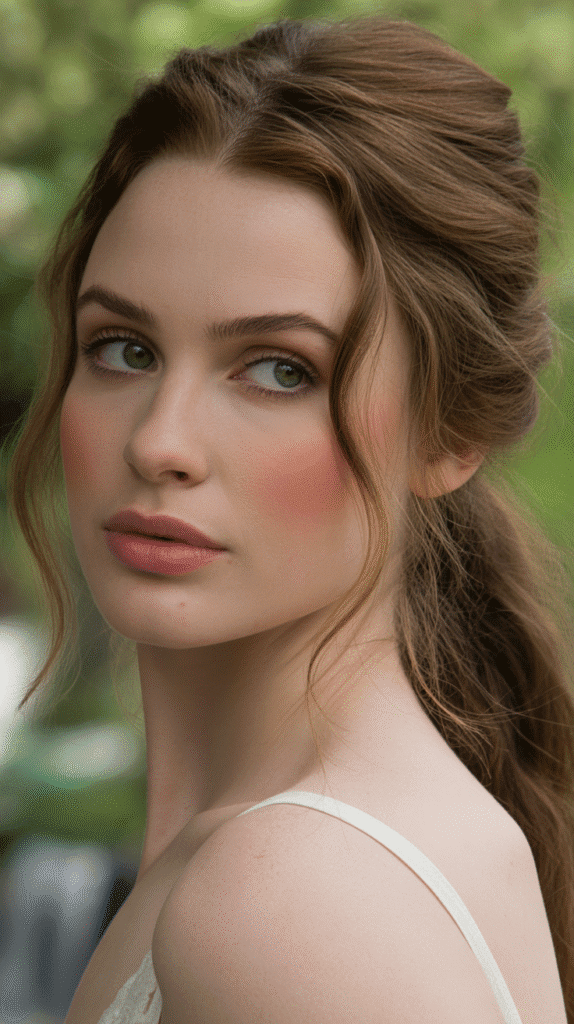
Chestnut brown provides warm, medium-brown tones with subtle red undertones that create natural-looking depth while complementing pale skin beautifully.
This versatile, low-maintenance shade works for virtually any lifestyle or professional environment.
Advantages:
- Chestnut offers enough contrast to prevent pale skin from looking washed out without being too dark or severe.
- The warm undertones add life and dimension to fair complexions, creating a healthy, vibrant appearance.
- This shade requires minimal maintenance compared to lighter or brighter colors, with roots blending naturally.
- Chestnut brown creates a polished, put-together look that works across all seasons and occasions.
Customization Options:
- Add subtle highlights or lowlights in caramel or auburn tones to increase dimension and visual interest.
- Request a slightly warmer or cooler version depending on whether your skin has pink or yellow undertones.
- Consider glossing treatments to add shine and enhance the natural warmth in the color.
- Pair chestnut with bronze or copper-toned makeup for a cohesive, harmonious overall appearance.
12. Ginger Red: Vibrant Natural Red Tones
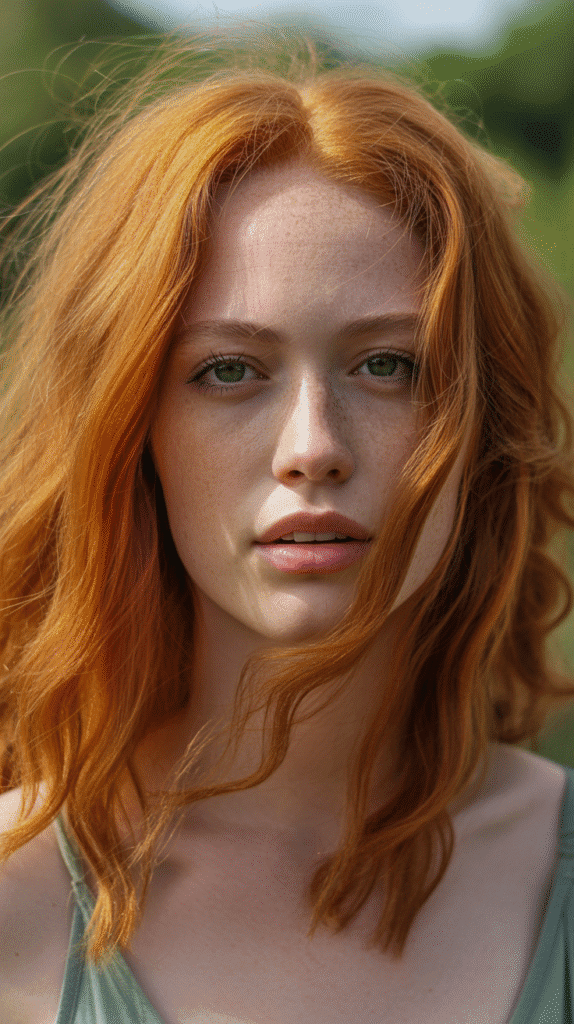
Ginger red features bright, natural red-orange tones that create the quintessential redhead appearance, offering maximum impact against pale skin and making green eyes absolutely luminous.
This shade celebrates the classic fair-skinned, green-eyed beauty archetype.
Standout Features:
- Ginger creates the most natural-looking red for pale skin, mimicking the appearance of naturally red hair.
- The orange undertones in ginger complement green eyes perfectly, creating color wheel harmony and visual pop.
- This shade adds significant warmth to fair complexions, preventing any appearance of pallor or dullness.
- Ginger red has cultural and aesthetic associations with beauty and uniqueness that make it particularly appealing.
Achieving Natural-Looking Ginger:
- Request a custom blend that matches your skin’s undertones for the most authentic-looking result.
- Incorporate multiple shades of red and copper throughout to mimic natural variation in red hair.
- Avoid flat, single-process color in favor of dimensional techniques like balayage or foiling.
- Use color-safe, sulfate-free products specifically formulated for red hair to maximize color longevity.
13. Champagne Blonde: Soft Neutral Elegance
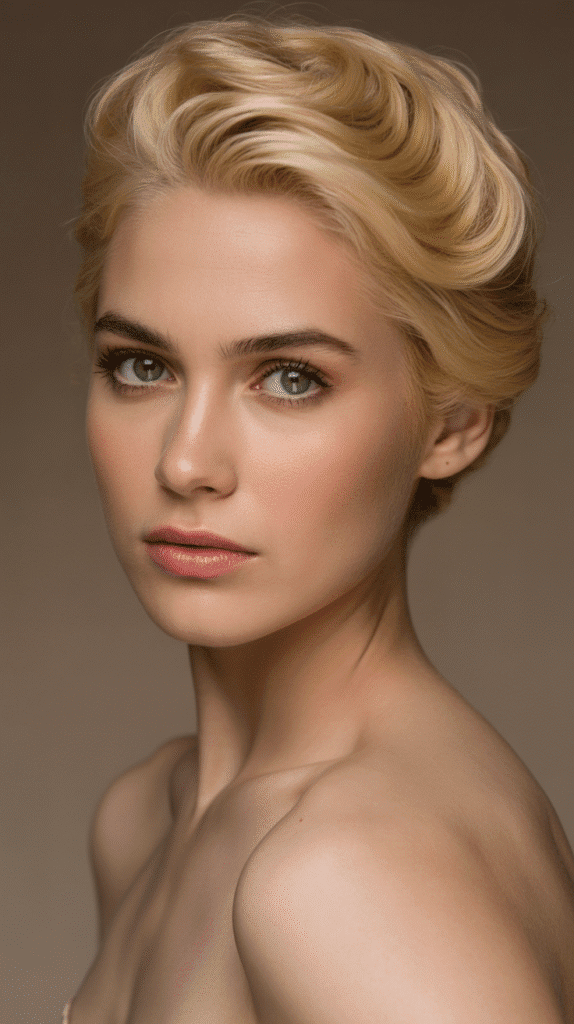
Champagne blonde offers neutral, soft blonde tones with subtle warmth that creates an elegant, understated look perfect for pale skin with green eyes.
This sophisticated shade provides brightness without the harsh contrast of platinum or the warmth of golden blonde.
Refined Qualities:
- Champagne’s neutral tone works universally with both warm and cool undertones in pale skin.
- The soft, muted quality prevents the color from overwhelming delicate fair complexions.
- This shade creates a polished, luxurious appearance that looks expensive and well-maintained.
- Champagne blonde makes green eyes appear more vibrant without competing for attention.
Maintenance Approach:
- Use alternating purple and silver shampoos to maintain the neutral tone without pulling too cool or warm.
- Schedule toning glosses every 4-6 weeks to refresh the champagne color and maintain its softness.
- Protect from environmental damage with UV-protectant products, as blonde tones are susceptible to discoloration.
- Consider root shadowing techniques to reduce maintenance frequency while adding dimension.
14. Espresso Brown: Rich Cool-Toned Depth
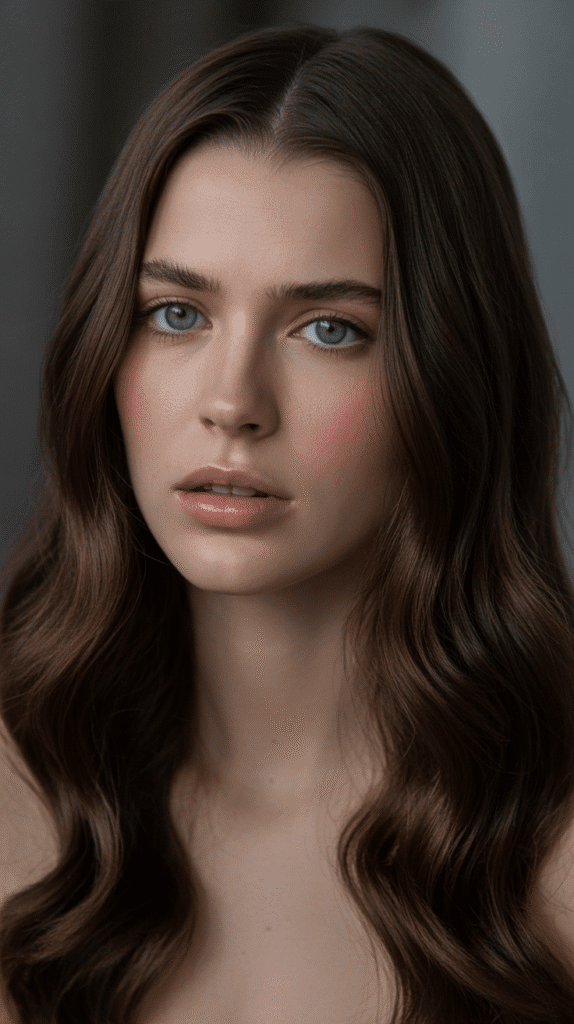
Espresso brown features deep, cool-toned brown shades that create striking contrast against pale skin while making green eyes appear more vibrant and jewel-like.
This dramatic shade works particularly well for those seeking a bold transformation.
Impact and Benefits:
- The depth of espresso creates maximum contrast with fair skin, resulting in a dramatic and memorable appearance.
- Cool undertones prevent the dark color from appearing too harsh or severe against pale complexions.
- Espresso brown requires relatively low maintenance compared to lighter colors, with roots blending naturally.
- This shade adds sophistication and intensity, creating a polished look that works in professional environments.
Application Considerations:
- Ensure your stylist uses cool-toned brown rather than warm to prevent the color from pulling orange or brassy.
- Add subtle highlights or dimension to prevent solid espresso from appearing too flat or heavy.
- Use blue or purple-toned shampoos occasionally to maintain the cool undertones and prevent warmth.
- Pair with cool-toned makeup like plum or berry shades to complement the overall color scheme.
15. Peach Tones: Soft Pastel Warmth
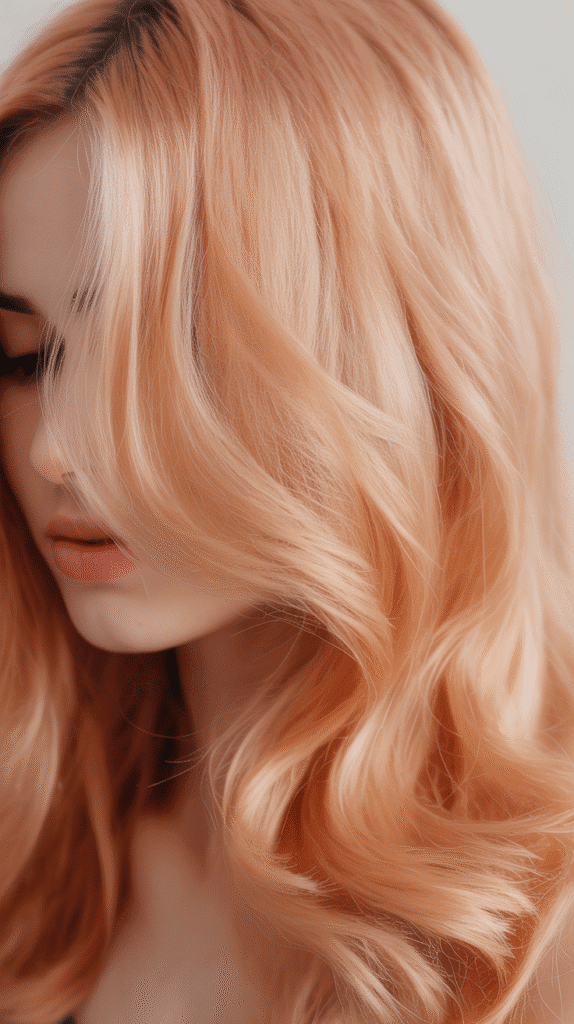
Peach hair color incorporates soft orange and pink tones that create a whimsical, fashion-forward look perfect for those wanting to experiment with unconventional colors.
This playful shade adds warmth to pale skin while creating unexpected contrast with green eyes.
Creative Appeal:
- Peach tones add a soft, romantic quality that flatters fair skin without overwhelming delicate features.
- The warm pastel creates an artistic, creative appearance that expresses personality and individuality.
- This shade photographs beautifully and creates a unique, memorable look that stands out on social media.
- Peach works surprisingly well with green eyes, as the warm-cool contrast creates visual interest.
Achieving and Maintaining Peach:
- Hair must be pre-lightened to very pale blonde for true peach tones to show properly.
- Use color-depositing conditioners in peach or coral tones weekly to maintain vibrancy between salon visits.
- Wash hair infrequently in cool water, as pastel colors fade significantly faster than traditional shades.
- Expect to refresh the color every 3-4 weeks for maximum vibrancy and impact.
16. Dark Auburn: Sophisticated Red-Brown Balance
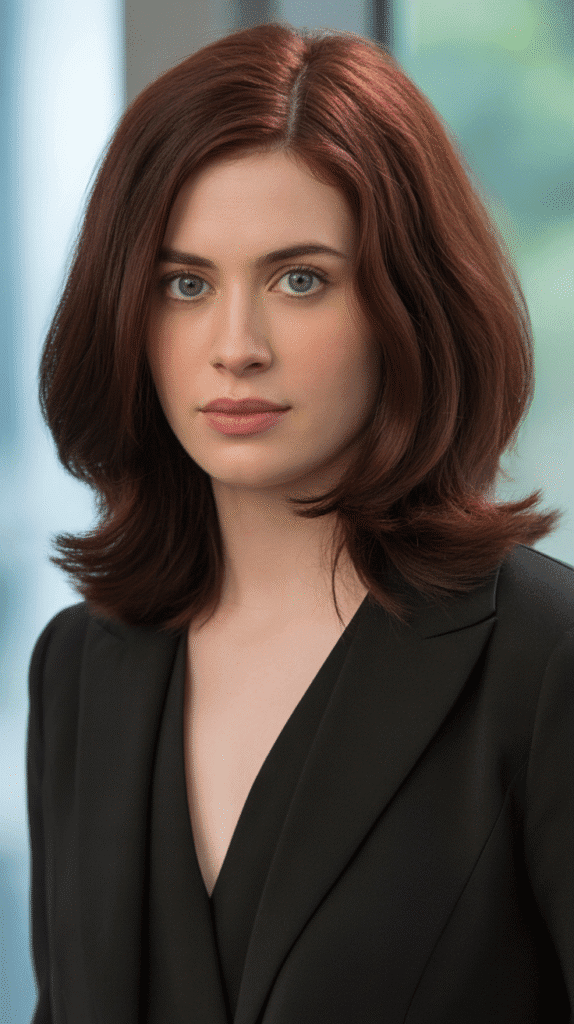
Dark auburn blends deep brown with rich red undertones, creating a sophisticated color that provides warmth without the brightness of lighter reds.
This refined shade offers the best of both worlds for pale skin and green eyes.
Balanced Benefits:
- Dark auburn adds warmth to fair skin while maintaining professional appropriateness and sophistication.
- The depth prevents the color from appearing too bright or attention-seeking while still providing warmth.
- Red undertones create subtle contrast that makes green eyes more noticeable without overwhelming them.
- This shade requires less maintenance than brighter reds, as the darker base camouflages root growth better.
Styling Guidance:
- Enhance dark auburn with red-toned glosses to refresh the color and add shine between appointments.
- Pair with warm-toned makeup in bronze, copper, and burgundy shades for a cohesive appearance.
- Add subtle copper or caramel highlights around the face to brighten and add dimension.
- Use color-safe products designed for red hair to prevent fading toward brown or orange.
17. Sandy Blonde: Natural Beach-Inspired Tones
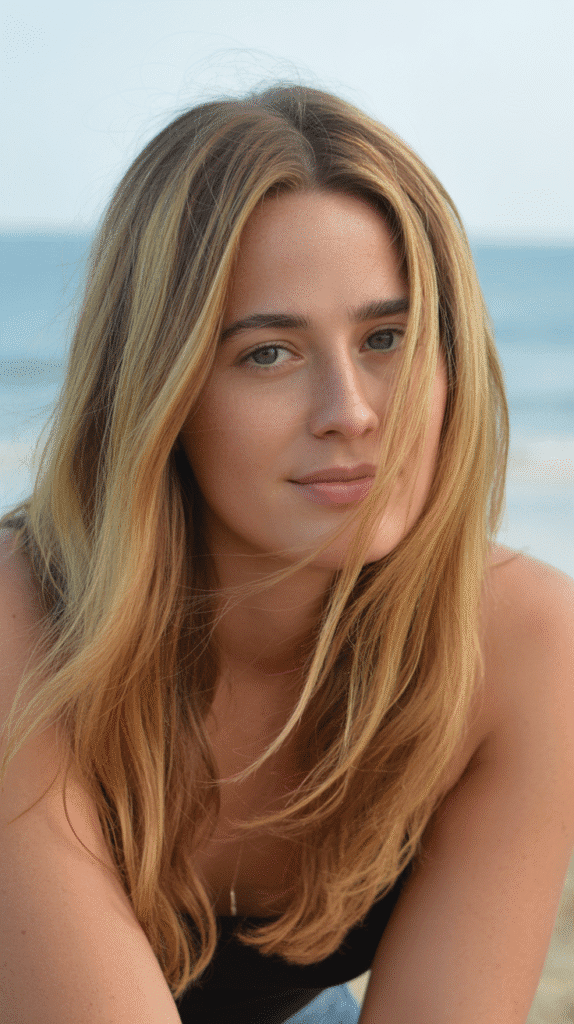
Sandy blonde features neutral-to-warm blonde tones with subtle brown lowlights that create a natural, effortless appearance perfect for pale skin with green eyes.
This understated shade mimics naturally sun-lightened hair for an organic, beachy look.
Natural Appeal:
- Sandy blonde creates a soft, natural appearance that doesn’t look overly processed or artificial.
- The combination of blonde and brown tones adds dimension that prevents pale skin from appearing flat.
- This shade works beautifully with green eyes by providing subtle warmth without overwhelming contrast.
- Sandy blonde requires less maintenance than platinum or ash tones, growing out naturally and gracefully.
Creating the Perfect Sandy Blonde:
- Request a blend of blonde and light brown tones throughout for realistic dimension and depth.
- Incorporate baby lights or balayage techniques for the most natural-looking sun-kissed effect.
- Avoid solid color application in favor of hand-painted techniques that mimic natural variation.
- Use moisturizing treatments to maintain hair health while keeping the color looking fresh and lived-in.
18. Copper Brown: Warm Dimensional Richness
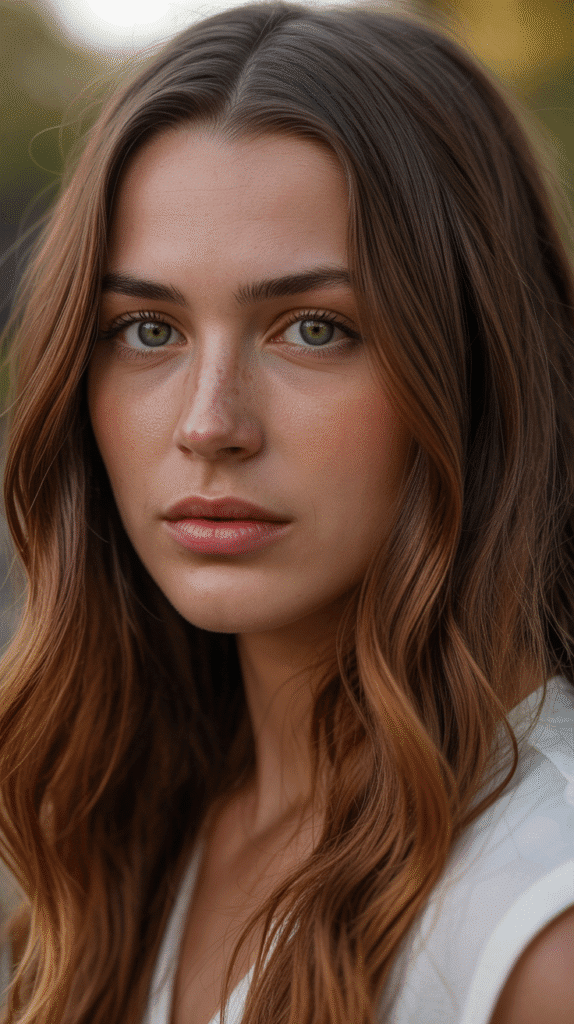
Copper brown combines medium brown with bright copper tones, creating a multidimensional color that adds significant warmth to pale skin while making green eyes pop dramatically.
This balanced shade offers richness without the high maintenance of solid copper.
Dimensional Advantages:
- The brown base provides depth and sophistication while copper adds vibrancy and warmth.
- This combination creates natural-looking dimension that appears expensive and professionally colored.
- Copper brown reflects light beautifully, creating shine and movement that flatters fair complexions.
- The warm tones complement the golden flecks often present in green eyes, creating overall harmony.
Application Techniques:
- Request copper highlights or balayage throughout a brown base for maximum dimension and natural appearance.
- Vary the placement of copper tones, concentrating brighter pieces around the face for a brightening effect.
- Use color-melting techniques to blend copper and brown seamlessly without harsh lines.
- Refresh copper tones with gloss treatments every 4-6 weeks to maintain vibrancy and shine.
19. Icy Blonde: Cool Platinum Variant
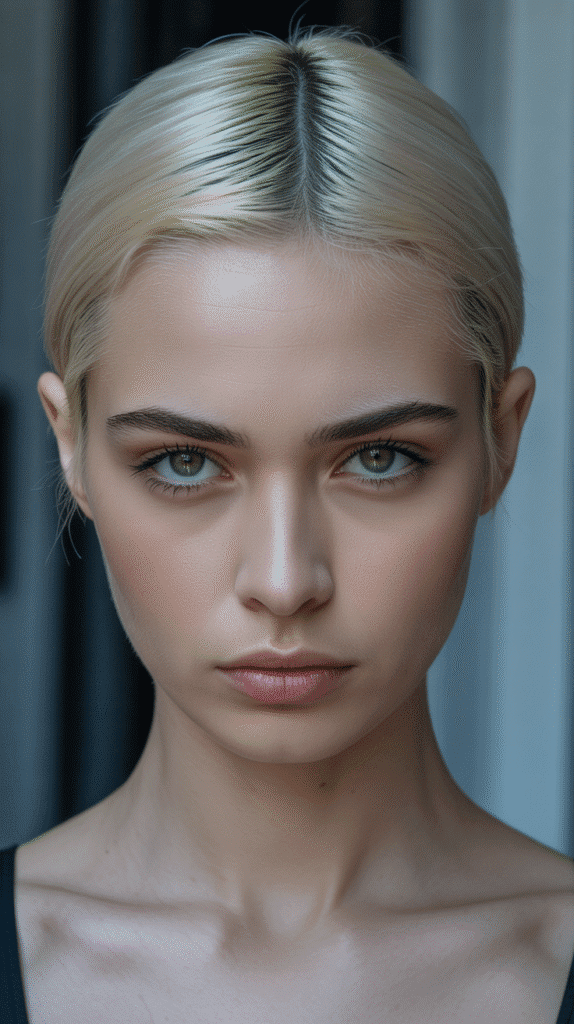
Icy blonde features the coolest possible blonde tones with subtle silver or white undertones, creating an ultra-modern look that provides extreme contrast with pale skin.
This daring shade makes green eyes appear extraordinarily vibrant and jewel-toned.
Bold Characteristics:
- Icy tones create the coolest possible blonde, appearing almost white or silver in certain lighting.
- The extreme contrast between icy hair and warm green eyes creates an unexpected and captivating combination.
- This shade gives an edgy, fashion-forward appearance that commands attention and makes a statement.
- Icy blonde works particularly well for those with cool or pink undertones in their pale skin.
Intensive Maintenance:
- Tone hair every 1-2 weeks using blue or purple-toned products to prevent any warmth from developing.
- Invest in bond-building treatments and deep conditioning masks to maintain hair health after extreme lightening.
- Avoid heat styling when possible, as icy blonde shows damage more readily than darker or warmer shades.
- Protect from environmental factors like minerals in water that can cause discoloration or green tones.
20. Warm Brunette: Rich Brown with Golden Undertones
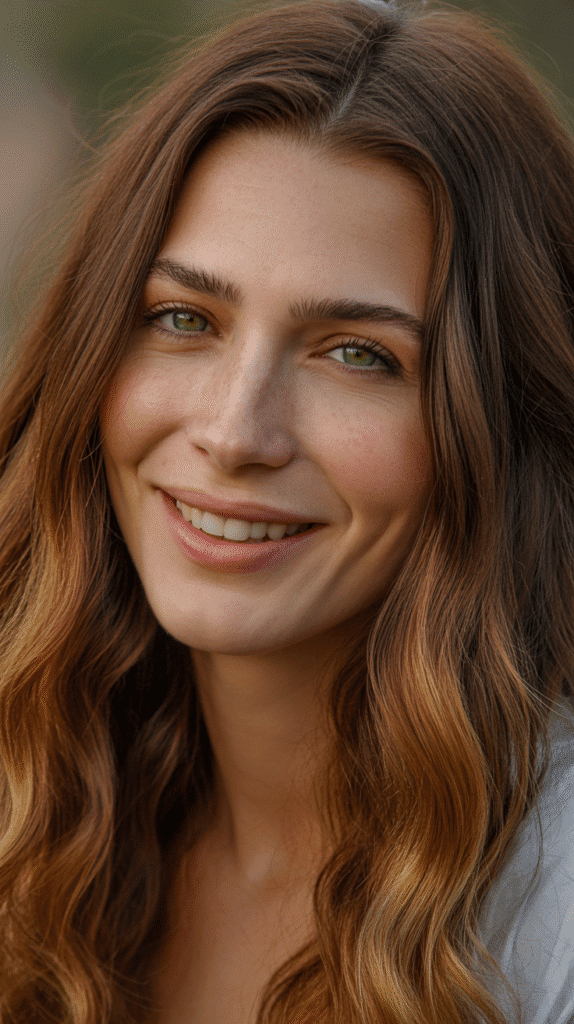
Warm brunette features rich brown tones with golden undertones that add life and dimension to pale skin while creating a polished, sophisticated appearance.
This versatile shade works across all seasons and complements green eyes beautifully.
Versatile Qualities:
- Golden undertones prevent dark brown from appearing too severe or harsh against fair skin.
- The warmth adds a healthy, sun-kissed quality to pale complexions without requiring bright colors.
- Warm brunette provides enough contrast to make green eyes stand out without overwhelming them.
- This shade requires minimal maintenance and grows out naturally, making it practical for busy lifestyles.
Enhancement Options:
- Add warm-toned highlights in caramel or honey shades to increase dimension and brightness.
- Use glossing treatments with gold or caramel tones to enhance warmth and add shine.
- Pair with warm-toned makeup in gold, bronze, and peachy shades for a cohesive overall look.
- Protect from sun exposure to prevent warm tones from fading or turning brassy.
21. Red-Violet: Bold Purple-Red Fusion
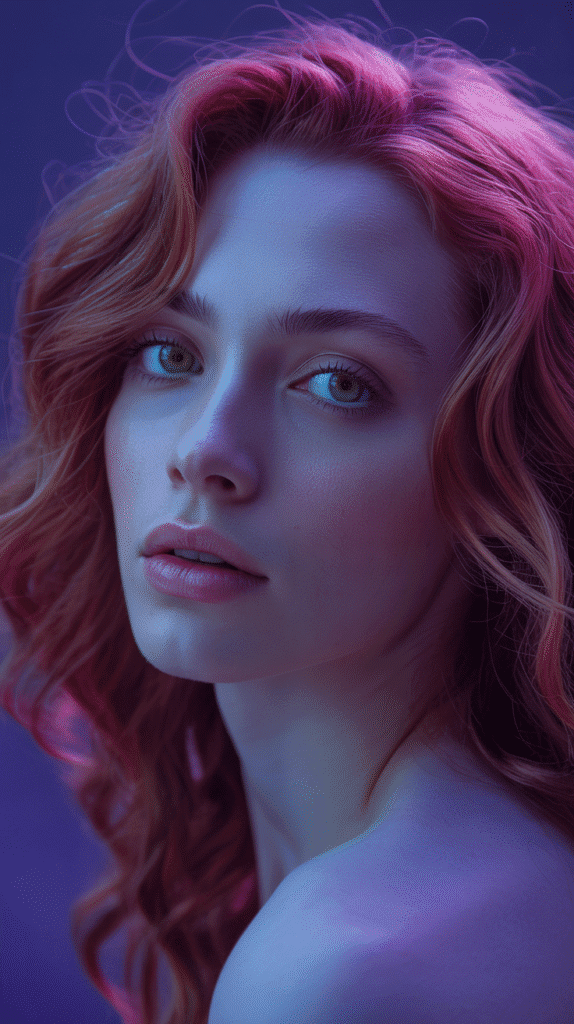
Red-violet combines red and purple tones to create a unique, bold color that makes a dramatic statement against pale skin while creating intriguing contrast with green eyes.
This unconventional shade expresses creativity and confidence.
Unique Impact:
- The purple undertones add cool contrast to the warmth of red, creating a complex and interesting color.
- Red-violet provides the drama of red hair while offering something more unusual and unexpected.
- Purple tones complement green eyes through color wheel relationships, creating visual harmony.
- This shade works particularly well for those wanting to stand out with an artistic, creative appearance.
Color Maintenance:
- Use color-depositing products specifically formulated for violet or burgundy tones to maintain vibrancy.
- Alternate between red and purple toning products to keep the perfect balance between both colors.
- Wash hair infrequently in cool water, as red-violet fades quickly and can turn pink or orange.
- Schedule color refreshes every 3-4 weeks to maintain the intensity and prevent significant fading.
22. Golden Brown: Warm Medium-Depth Balance
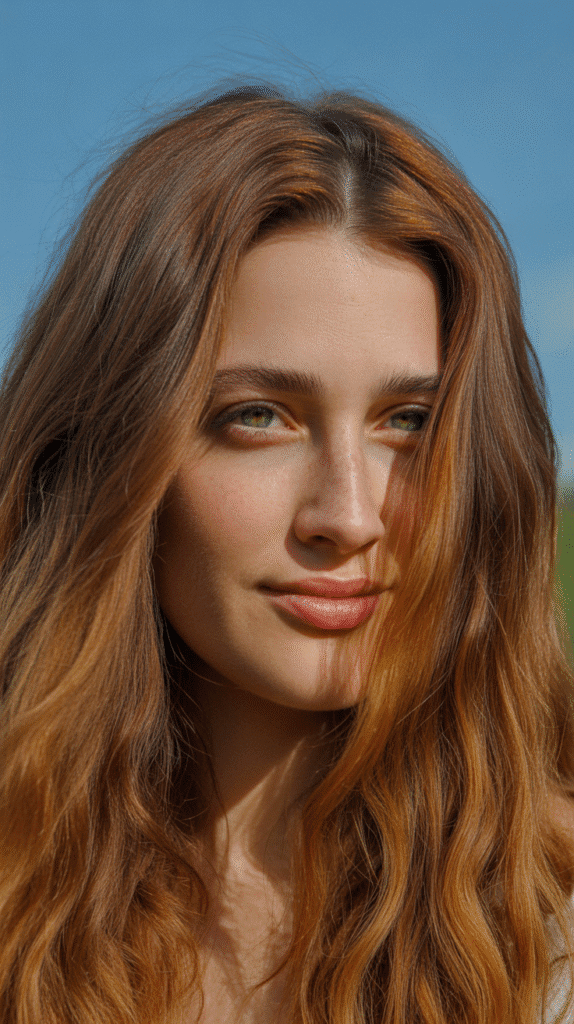
Golden brown offers medium-depth brown with rich golden undertones, creating a balanced color that adds warmth to pale skin without being too light or too dark.
This flattering shade complements green eyes with its warm, honeyed quality.
Balanced Appeal:
- Golden tones add warmth and brightness to fair skin without the maintenance requirements of blonde.
- The medium depth provides contrast without being as severe as very dark colors.
- This shade creates a naturally sun-kissed appearance that looks effortless and organic.
- Golden brown works universally with various makeup styles and fashion choices, offering versatility.
Creating Golden Brown:
- Request warm-toned brown with golden highlights or balayage for maximum dimension and natural appearance.
- Use glosses with honey or caramel tones to enhance the golden quality and add shine.
- Avoid ash or cool-toned products that could neutralize the warm golden undertones.
- Pair with warm-toned makeup in gold, bronze, and warm brown shades for cohesive looks.
23. Mahogany Red: Deep Red with Brown Richness
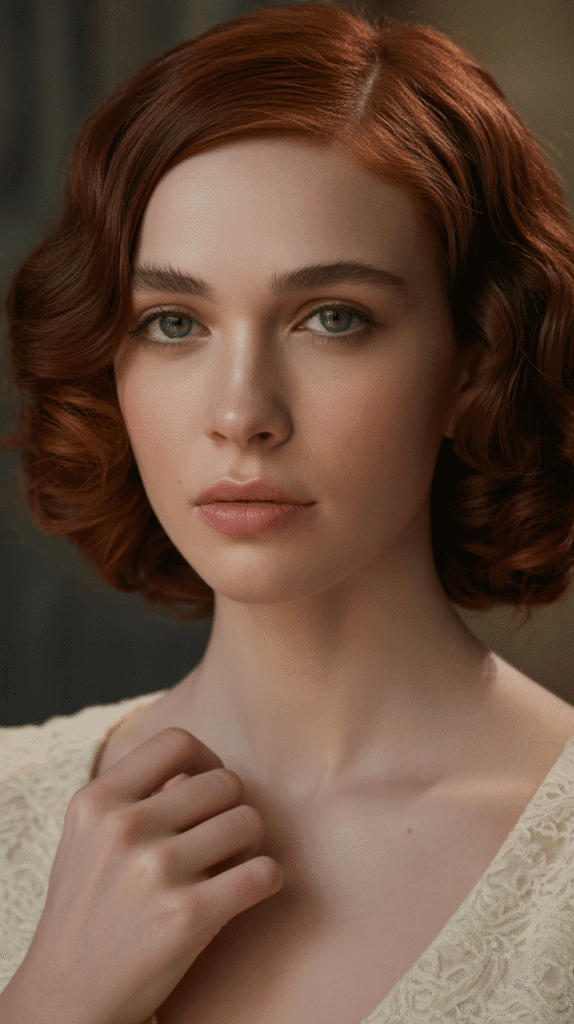
Mahogany red features deep red tones blended with brown for a rich, luxurious color that creates sophisticated warmth against pale skin.
This refined shade offers drama without the brightness of true red hair.
Sophisticated Features:
- The brown base adds depth and sophistication while red tones provide warmth and visual interest.
- Mahogany red creates strong contrast with pale skin while remaining appropriate for professional environments.
- This shade makes green eyes appear more luminous and jewel-toned through color contrast.
- The depth of mahogany red requires less frequent touch-ups than brighter red shades.
Color Care:
- Use red-toned color-depositing products to maintain vibrancy and prevent fading toward brown.
- Protect from heat styling and sun exposure, as red pigments are particularly vulnerable to fading.
- Apply glossing treatments every 4-6 weeks to refresh the red tones and maintain shine.
- Wash hair in cool water with sulfate-free products to extend color longevity between salon visits.
24. Butterscotch Blonde: Rich Golden-Blonde Warmth
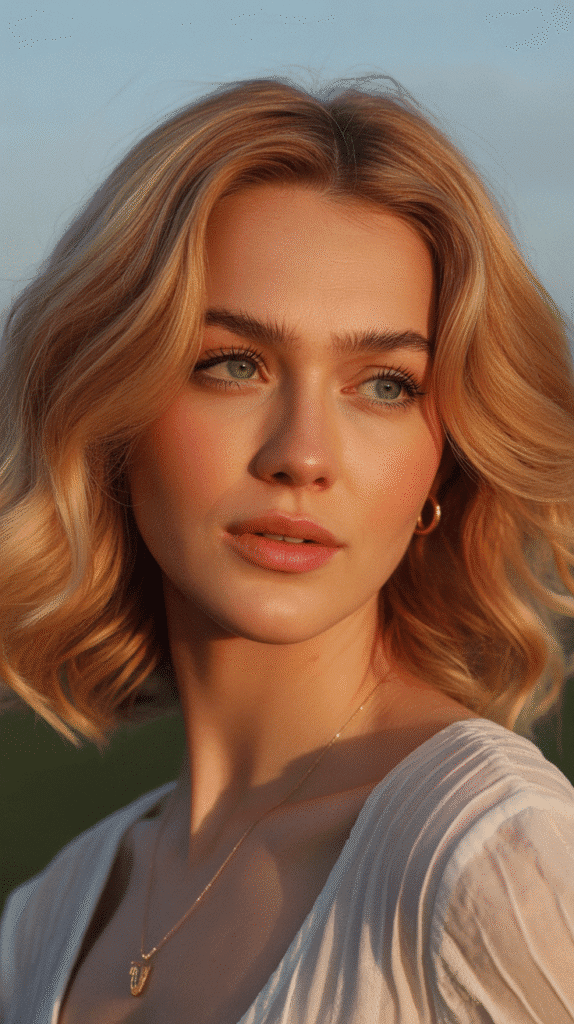
Butterscotch blonde features rich golden-blonde tones with caramel undertones, creating a warm, dimensional color that flatters pale skin beautifully while enhancing green eyes.
This sweet, inviting shade offers warmth without being overly bright.
Warm Characteristics:
- Butterscotch adds significant warmth to fair skin, creating a healthy, radiant glow.
- The golden-caramel tones complement the warm flecks in green eyes, creating harmonious color relationships.
- This shade provides blonde lightness while maintaining enough depth to prevent pale skin from looking washed out.
- Butterscotch blonde photographs beautifully and maintains its richness in various lighting conditions.
Achieving the Look:
- Request balayage or dimensional coloring rather than solid application for the most natural butterscotch effect.
- Combine multiple shades of golden blonde and light brown to create realistic dimension and depth.
- Use warm-toned glosses to maintain the butterscotch quality and prevent the color from turning ashy.
- Pair with warm-toned makeup in peachy and golden shades for a cohesive, glowing appearance.
25. Cool Brown: Ash-Toned Sophistication
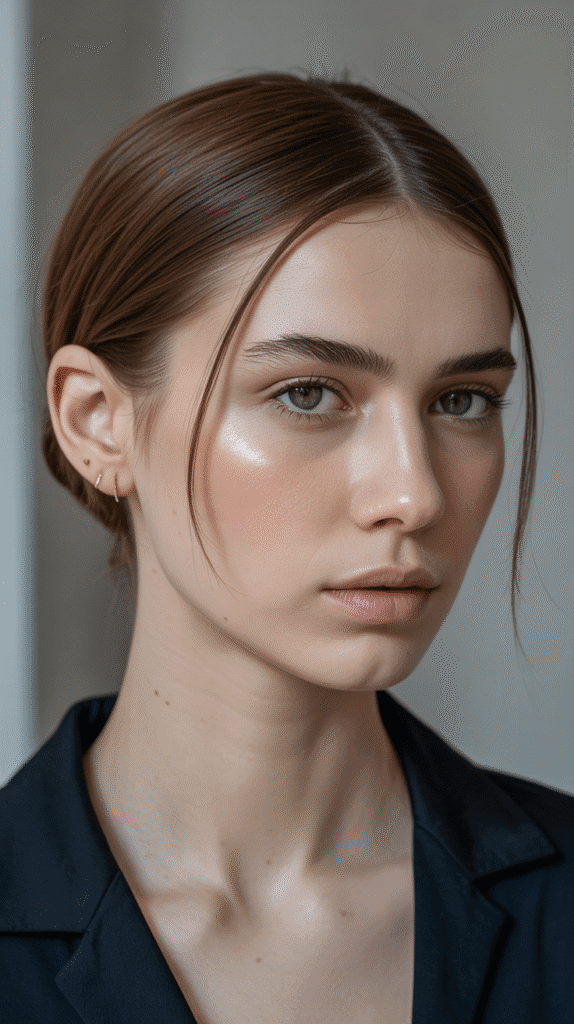
Cool brown features brown tones with ash or cool undertones, creating a sophisticated color that provides contrast without warmth.
This modern shade works particularly well for pale skin with pink or cool undertones and creates interesting contrast with green eyes.
Modern Appeal:
- Cool undertones create a contemporary, fashion-forward appearance that looks polished and intentional.
- The lack of warmth prevents any orange or brassy tones that can clash with cool-toned pale skin.
- Cool brown creates subtle contrast that allows green eyes to stand out without competing hair color.
- This shade pairs beautifully with cool-toned makeup and creates a cohesive, modern overall aesthetic.
Maintenance Strategy:
- Use blue or purple-toned shampoos occasionally to maintain the cool undertones and prevent warmth.
- Request cool-toned glosses during salon visits to refresh the color and enhance the ash quality.
- Avoid products with warm or golden tones that could shift the color away from its cool base.
- Protect from sun exposure, which can cause cool browns to develop unwanted warm tones.
26. Bright Red: Bold Primary Color Statement
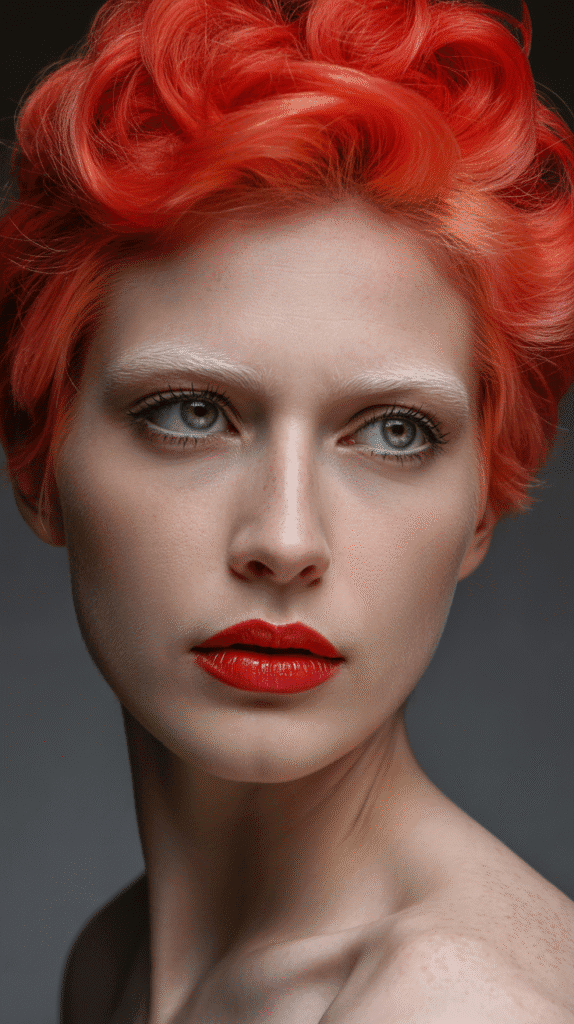
Bright red represents the boldest choice, featuring vivid primary red tones that create maximum impact against pale skin and make green eyes absolutely electric.
This daring shade requires confidence and commitment but delivers unparalleled drama.
Maximum Impact:
- Bright red creates the strongest possible contrast with pale skin, resulting in an unforgettable appearance.
- The complementary relationship between red and green makes this combination scientifically optimal for eye color enhancement.
- This shade commands attention and expresses bold confidence and individuality.
- Bright red has cultural associations with passion, creativity, and uniqueness that enhance its appeal.
High-Maintenance Reality:
- Bright red requires the most intensive maintenance of any hair color, fading rapidly after each wash.
- Use professional color-depositing treatments specifically formulated for bright red tones after every 2-3 washes to maintain intensity.
- Limit washing to once or twice weekly maximum, using dry shampoo between washes to preserve color vibrancy.
- Invest in color-sealing treatments and products that lock pigment into the hair shaft for extended longevity.
- Avoid all chlorinated water, salt water, and excessive sun exposure, as these factors cause rapid and dramatic fading.
- Schedule color refresh appointments every 3-4 weeks to maintain the brightness and prevent fading to orange or pink.
Understanding Your Skin’s Undertones
Determining your skin’s undertones helps you choose the most flattering hair color from the 26 options presented.
Pale skin can have cool, warm, or neutral undertones, and identifying yours ensures optimal color selection.
Identifying Cool Undertones:
- Your veins appear blue or purple rather than green when viewed on your inner wrist.
- Silver jewelry tends to look more flattering on your skin than gold jewelry.
- Your skin has pink, red, or bluish tints, especially noticeable in natural lighting.
- You burn easily in the sun and rarely develop golden tans.
- Cool-toned hair colors like ash blonde, platinum, cool brown, and burgundy will complement your complexion best.
Identifying Warm Undertones:
- Your veins appear green or olive-toned when examined on your inner wrist.
- Gold jewelry looks more harmonious with your skin tone than silver.
- Your skin has yellow, peachy, or golden tints that become more apparent in sunlight.
- You tend to tan more easily and develop golden or bronze tones with sun exposure.
- Warm-toned hair colors like copper, honey blonde, ginger, auburn, and golden brown will enhance your natural coloring.
Identifying Neutral Undertones:
- Your veins appear blue-green, making it difficult to determine if they’re purely blue or green.
- Both silver and gold jewelry look equally flattering on your skin.
- Your skin doesn’t have obvious pink or yellow tints and appears relatively balanced.
- You can tan but may also experience some burning depending on sun exposure duration.
- You have the most flexibility and can wear both warm and cool hair colors successfully, including champagne blonde, sandy blonde, and mahogany shades.
Color Selection Guide by Season
Different seasons can influence which hair colors look most harmonious and appropriate, helping you time your color transformation for maximum impact.
Spring and Summer Recommendations:
- Lighter, brighter colors like strawberry blonde, honey blonde, and butterscotch blonde capture the sunny, warm-weather aesthetic.
- Sandy blonde and caramel highlights create natural sun-kissed effects that align with seasonal expectations.
- Peach tones and rose gold offer playful, seasonal options for those wanting trendy summer colors.
- Copper penny and ginger red provide vibrant warmth that complements summer’s golden light and outdoor activities.
Fall and Winter Recommendations:
- Deeper, richer colors like burgundy, mahogany red, and espresso brown suit the cooler months beautifully.
- Dark auburn and warm brunette provide sophisticated depth appropriate for autumn and winter fashion.
- Cool brown and ash blonde create elegant, refined looks that pair well with winter’s muted palette.
- Red-violet and mahogany brown offer luxurious richness that complements fall’s jewel-toned aesthetic.
Year-Round Options:
- Chestnut brown, golden brown, and warm brunette maintain appeal across all seasons with their balanced tones.
- Rich auburn and copper brown provide warmth without being seasonally specific.
- Champagne blonde and sandy blonde offer versatility that works in any season with appropriate styling.
Professional Consultation Tips
Consulting with a professional colorist ensures you achieve the best possible results when transforming your hair color, especially with pale skin and green eyes that require careful color selection.
Questions to Ask Your Colorist:
- Request their professional opinion on which shades from your favorites list would work best with your specific skin undertones and eye color intensity.
- Ask about the condition of your current hair and whether it can safely achieve your desired color without excessive damage.
- Inquire about realistic maintenance requirements, including time commitment and financial investment for your chosen shade.
- Discuss whether gradual transitions through highlights or balayage might be better than all-over color for your first transformation.
- Request information about color-safe products and at-home maintenance routines specific to your chosen shade.
Bringing Visual References:
- Collect multiple photos showing your desired color in different lighting conditions for accurate representation.
- Include images of people with similar skin tones and eye colors to help your colorist understand the look you’re pursuing.
- Save photos showing both the color itself and the overall vibe or aesthetic you want to achieve.
- Be prepared to discuss what you like specifically about each reference photo to clarify your vision.
Understanding Realistic Expectations:
- Discuss whether your natural hair color and current condition can achieve your desired shade in one session or requires multiple appointments.
- Ask about color longevity and how quickly your chosen shade typically fades with normal wear.
- Understand the damage potential of significant color changes and whether your hair health can sustain the transformation.
- Learn about transitional phases if growing out or changing your color in the future.
Hair Health and Color Maintenance
Maintaining healthy hair while sporting your new color ensures longevity, vibrancy, and overall appearance quality that complements your pale skin and green eyes.
Essential Hair Care Products:
- Invest in professional sulfate-free shampoo and conditioner specifically formulated for color-treated hair to prevent premature fading.
- Use weekly deep conditioning masks or treatments to restore moisture and repair damage from chemical processing.
- Apply heat protectant sprays or serums before any thermal styling to prevent color degradation and structural damage.
- Incorporate bond-building treatments like Olaplex or similar products to strengthen hair compromised by lightening or coloring.
- Use color-depositing conditioners or glosses between salon visits to refresh your shade and maintain vibrancy.
Washing and Styling Best Practices:
- Wash hair in lukewarm or cool water rather than hot, as heat opens the cuticle and releases color molecules.
- Limit washing frequency to 2-3 times weekly maximum, using dry shampoo between washes to extend color life.
- Avoid washing hair within 48-72 hours after coloring to allow the color to fully set and bond with hair.
- Use microfiber towels or t-shirts to dry hair gently without roughing up the cuticle and causing color loss.
- Minimize heat styling frequency and use the lowest effective temperature settings when styling is necessary.
Environmental Protection:
- Apply UV-protectant products before sun exposure, as ultraviolet rays fade hair color and damage hair structure.
- Wear hats or scarves when spending extended time outdoors to physically protect hair from sun damage.
- Rinse hair immediately after swimming in chlorinated or salt water to prevent discoloration and damage.
- Use clarifying treatments monthly to remove mineral buildup from hard water that can alter color appearance.
Makeup Coordination for Enhanced Results
Coordinating your makeup with your new hair color enhances the overall harmony of your appearance and makes your green eyes even more striking against pale skin.
Makeup for Warm Hair Colors (Auburn, Copper, Ginger, Honey):
- Choose warm-toned eyeshadows in bronze, copper, gold, and warm brown shades that harmonize with hair color.
- Apply peachy, coral, or warm pink blushes that complement the warmth in your hair and add life to pale skin.
- Select nude or peachy lip colors for everyday wear, with brick red or coral options for more dramatic looks.
- Use bronze or gold highlighters to add warmth and dimension to your complexion.
- Consider warm brown or bronze eyeliner instead of harsh black for a softer, more cohesive appearance.
Makeup for Cool Hair Colors (Ash Blonde, Platinum, Cool Brown, Espresso):
- Opt for cool-toned eyeshadows in taupe, cool brown, plum, and gray shades that complement your hair.
- Apply pink, mauve, or cool rose blushes that work with cool hair tones and flatter fair skin.
- Choose nude-pink, mauve, or berry lip colors that align with the cool color palette.
- Use champagne or pearl highlighters for luminosity without introducing warm tones.
- Consider gray, charcoal, or cool brown eyeliner for definition that matches your color scheme.
Universal Strategies for Green Eyes:
- Purple, plum, and burgundy eyeshadows make green eyes appear more vibrant through complementary color relationships.
- Bronze and copper tones enhance the golden flecks often present in green eyes, creating depth and dimension.
- Avoid green eyeshadow, as it can compete with eye color rather than enhance it.
- Use brown or burgundy mascara for a softer look than black, especially with lighter hair colors.
- Apply eyeliner to the upper lash line primarily, keeping lower liner minimal to prevent closing in green eyes.
Budget Considerations and Salon Selection
Understanding the financial investment required for your chosen hair color helps you plan appropriately and select the right salon for your needs.
Cost Factors by Color Type:
- All-over single-process colors like chestnut brown or warm brunette typically cost between $75-150 depending on salon location and reputation.
- Highlighting techniques including balayage, foiling, and ombre range from $150-350 based on complexity and time required.
- Extreme lightening for platinum, icy blonde, or bright fashion colors often costs $200-500 due to multiple processing steps.
- Vivid fashion colors like bright red, peach, or rose gold may require $250-400 for initial application plus frequent maintenance.
- Corrective color to fix previous color mistakes or achieve difficult transformations can cost $300-600 or more.
Ongoing Maintenance Costs:
- Budget for salon visits every 3-12 weeks depending on your chosen color, with high-maintenance shades requiring monthly appointments.
- Professional color-safe products typically cost $20-40 per bottle but last longer and protect your color investment.
- Glossing treatments between color appointments cost $50-100 and significantly extend vibrancy and shine.
- Deep conditioning treatments at salons range from $30-75 but can be done at home with quality products for less.
Choosing the Right Salon:
- Research salons specializing in color services, particularly those with experience in your desired technique or shade.
- Read reviews specifically mentioning colorists’ work with pale skin tones and maintaining vivid or delicate colors.
- Request consultations before booking to discuss your vision and assess the colorist’s expertise and communication style.
- View before-and-after portfolios of the colorist’s previous work to ensure their aesthetic aligns with your goals.
- Don’t automatically choose the cheapest option, as skilled colorists protect your hair health while achieving beautiful results.
Lifestyle Compatibility Assessment
Ensuring your chosen hair color aligns with your lifestyle prevents frustration and helps you select a shade you’ll love long-term.
Professional Environment Considerations:
- Conservative workplaces may have unwritten expectations favoring natural-looking colors like chestnut, warm brunette, or honey blonde over fashion shades.
- Creative industries typically welcome bolder choices like bright red, rose gold, or even pastel tones without professional consequences.
- Client-facing roles might benefit from polished, well-maintained colors that convey professionalism regardless of shade intensity.
- Consider whether your workplace culture embraces individuality or expects conformity when making color decisions.
Activity and Maintenance Compatibility:
- Athletes and active individuals who wash hair frequently should avoid high-maintenance colors like bright red or platinum blonde.
- Busy professionals with limited time for styling should choose lower-maintenance options like dark auburn or golden brown.
- Frequent swimmers must accept significant fading and damage or avoid light or vivid colors entirely.
- Those who enjoy spontaneous travel should choose colors that look acceptable even when slightly grown out or faded.
Personal Style Alignment:
- Ensure your hair color complements your wardrobe color palette, as some shades clash with certain clothing colors.
- Consider whether you prefer high-impact, attention-getting looks or subtle, natural-appearing enhancements.
- Think about your comfort level with standing out, as dramatic hair colors attract comments and attention.
- Assess whether you enjoy experimenting with appearance or prefer consistent, predictable looks over time.
Transitioning Between Colors
Understanding how to safely and effectively transition from one color to another protects hair health and achieves better results.
Growing Out Permanent Color:
- Request lowlights that match your natural color to blend regrowth and create a gradual transition period.
- Consider shadow root techniques that deliberately darken roots for a lived-in look that requires less maintenance.
- Use strategic highlighting around the face to distract from root regrowth and maintain a polished appearance.
- Be patient with the process, as rushing color removal can cause severe damage requiring extensive repair.
Lightening from Dark to Light:
- Expect multiple sessions spaced 4-6 weeks apart to safely lighten hair without excessive damage or breakage.
- Use bond-building treatments during each lightening session to maintain hair integrity throughout the process.
- Consider transitional colors like caramel highlights or copper brown before attempting dramatic platinum or ash blonde changes.
- Consult with experienced colorists about whether your hair’s current condition can safely achieve your desired lightness.
Changing Color Families:
- Moving from warm to cool or vice versa may require color removal or correction before applying the new shade.
- Fashion colors like pink, peach, or rose gold must fade substantially before successfully achieving natural shades.
- Red pigments are particularly stubborn and may require professional color removal before changing to blonde or ash tones.
- Always consult professionals rather than attempting dramatic color changes at home to prevent costly mistakes.
Common Mistakes to Avoid
Learning from others’ experiences helps you avoid common pitfalls when coloring pale skin with green eyes.
Color Selection Errors:
- Choosing colors based solely on trends rather than what complements your specific skin undertones and eye color leads to unflattering results.
- Selecting shades too similar to your natural color wastes money without creating noticeable change or enhancement.
- Picking colors that clash with your skin’s undertones makes pale skin appear sallow, washed out, or unhealthy.
- Ignoring lifestyle compatibility results in choosing high-maintenance colors you can’t realistically maintain long-term.
Application and Process Mistakes:
- Attempting complex color transformations at home without professional expertise causes uneven color, damage, and expensive corrections.
- Using box dyes from drugstores on previously colored hair creates unpredictable results and potential color disasters.
- Over-processing hair by coloring too frequently damages hair structure and causes breakage and severe dryness.
- Skipping strand tests before full application risks allergic reactions or unexpected color outcomes.
Maintenance Failures:
- Using regular shampoos instead of color-safe formulas causes rapid fading and requires more frequent salon visits.
- Washing hair too frequently or in hot water strips color molecules and shortens the lifespan of your investment.
- Neglecting heat protection when styling accelerates fading and damages hair compromised by chemical processing.
- Failing to protect hair from sun, chlorine, and environmental factors causes premature color loss and discoloration.
Seasonal Color Refresh Ideas
Refreshing your hair color with subtle changes throughout the year keeps your look current without requiring complete transformations.
Spring Refresh Techniques:
- Add lighter face-framing pieces to existing color for a subtle brightening effect that captures spring’s lighter energy.
- Refresh warm tones with caramel or honey-toned glosses that add vibrancy without changing the base color.
- Consider adding subtle peach or rose gold tones to blonde bases for a trendy seasonal update.
- Lighten ends slightly through balayage for a sun-kissed effect that transitions naturally from winter darkness.
Summer Maintenance:
- Enhance existing highlights with additional lighter pieces to mimic natural sun-lightening effects.
- Add copper or golden tones to brown bases for warmth that complements summer tans on pale skin.
- Refresh vivid colors like bright red or ginger with intensive color-depositing treatments before beach vacations.
- Consider temporary fashion shades for summer if you want experimentation without permanent commitment.
Fall Transformation:
- Deepen existing colors with lowlights in richer, darker shades that align with autumn aesthetics.
- Add burgundy, mahogany, or auburn tones to create warmth appropriate for fall fashion and lighting.
- Transition from summer blondes to richer butterscotch or golden brown shades for seasonal cohesion.
- Incorporate red-violet or copper brown for trendy fall looks that remain flattering on pale skin.
Winter Updates:
- Add cool-toned lowlights or all-over color for sophisticated depth appropriate to winter’s darker days.
- Enhance espresso, cool brown, or dark auburn shades with rich glosses that create luxurious shine.
- Consider platinum or icy blonde for dramatic winter transformation that stands out in season’s muted palette.
- Refresh burgundy or mahogany red tones for rich, jewel-toned winter elegance.
The Psychology of Hair Color Change
Understanding the emotional and psychological impacts of changing hair color helps you prepare for both positive and challenging aspects of transformation.
Confidence and Self-Expression:
- Dramatic color changes often boost confidence by allowing self-expression and demonstrating willingness to take risks.
- Finding a truly flattering shade that enhances natural features creates positive feedback loops that reinforce self-esteem.
- Bold color choices can signal life transitions, new beginnings, or personal growth phases to yourself and others.
- Successfully maintaining a challenging color demonstrates commitment and care that can translate to other life areas.
Social Responses and Adjustment:
- Prepare for increased attention and comments, both positive and occasionally negative, especially with dramatic changes.
- Close friends and family may need adjustment periods to recognize you with significantly different coloring.
- Some people experience temporary identity confusion when their appearance changes dramatically from familiar norms.
- Social media reactions to new color can provide validation but shouldn’t be the primary motivation for color choices.
Managing Expectations:
- Understand that color won’t solve underlying self-esteem issues, though it can provide temporary mood boosts and fun.
- Recognize that maintenance requirements may become burdensome over time, potentially causing stress rather than joy.
- Accept that color might not look exactly like inspiration photos due to individual hair texture, density, and starting color.
- Prepare financially and temporally for ongoing commitment required to maintain your chosen shade properly.
Conclusion
Discovering the perfect shade from these 26 flattering hair colors for pale skin with green eyes that turn heads transforms not only your appearance but also your confidence and self-expression.
Whether you choose the warm vibrancy of copper penny, the sophisticated depth of espresso brown, the romantic softness of strawberry blonde, or the bold statement of bright red, the key lies in selecting colors that harmonize with your skin’s undertones while making those stunning green eyes the focal point of your beauty.
Remember that successful hair color goes beyond simply choosing a pretty shade—it requires understanding maintenance commitments, protecting hair health, coordinating makeup appropriately, and ensuring lifestyle compatibility for long-term satisfaction.
With proper professional guidance, quality products, and realistic expectations, your new hair color will enhance your natural beauty, complement your pale complexion perfectly, and ensure your green eyes captivate everyone you meet.
The journey to finding your ideal shade among these 26 flattering hair colors for pale skin with green eyes that turn heads may require patience and experimentation, but the confidence and beauty you’ll gain make every effort worthwhile.
